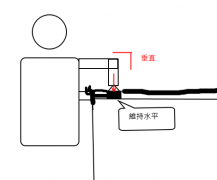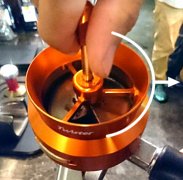Comparison of the effects of different powder distribution methods of espresso the best method of coffee powder distribution is beating

Professional coffee knowledge exchange more coffee bean information please follow the coffee workshop (Wechat official account cafe_style)
The correct method of filling Italian Coffee Powder Press Coffee Powder
The experiment of testing different powder distribution methods is a difficult journey, and this article is to make you understand what happens in the short operation from bean grinder to espresso machine.
Earlier, I launched a questionnaire survey. For the results and discussion of the questionnaire, please poke here. This article is like a pseudoscience paper. The reason why it is not written strictly according to the format and writing of the scientific paper is that I think it is easy to read and understand. In other words, I think it is very important to write my experimental article in such an easy way.
Abstract
The test I did may seem a little strange at first, but I promise it will be a delicate and meaningful indicator. In essence, this test measured the ability of a powder distribution method to steadily and evenly distribute coffee powder of a certain quality in a fixed capacity powder bowl.
Brief introduction
As mentioned in the previous article, the evaluation of powder distribution methods should be based on the quality, consistency, speed and cleanliness of the extraction. It is also difficult and time-consuming to test all the powder distribution methods at once. So I will break down one by one and use a series of tests to help understand. The most basic way to spread the powder is to try to distribute the coffee powder evenly in the powder bowl. The result should be that the density of coffee powder is the same everywhere in the powder bowl. The process of trying to reach the "maximum uniformity limit" is the best part of the test, because it will never be "too uniform", which is endless. Once we understand this, it becomes very easy to design a test to measure uniformity.
Materials and methods
The test I designed was so simple that it didn't even need to actually brew coffee, just to test the uniformity and consistency of coffee powder in the powder bowl. My operation is as follows: I chose the three most representative ideas from a variety of powder distribution methods. The reason for this is that many methods are actually very similar, which can save time.
1. Direct filling and pressing
-pick up the powder from the bean grinder and move the brewing handle so that the coffee powder falls into the powder bowl as evenly as possible
-then tap the cooking handle twice on the powder rack.
-fill in and press.
2. Wipe the surface of the coffee powder evenly with your hand / palm / tool. Here I choose to use the Stockfleth method that I use most easily. )
-pick up the powder from the bean grinder and move the brewing handle so that the coffee powder falls into the powder bowl as evenly as possible
-then tap the cooking handle twice on the powder rack.
-turn the fingers and the brewing handle to make the coffee powder on the surface very smooth and uniform
-fill in and press.
3. Knock up and down and tap horizontally
-pick up the powder from the bean grinder and move the brewing handle so that the coffee powder falls into the powder bowl as evenly as possible
-then tap the cooking handle twice on the powder rack.
-Pat the side of the cooking handle with your palm until the coffee powder in the powder bowl is highly consistent.
-fill in and press.
In each of the above three processes, I used a slight excess of coffee powder (0.5-1g more than my goal of 20.8g), then used their own cloth method to distribute the powder, and then filled it very hard until the coffee powder could no longer be compressed. This is much more powerful than it takes me to actually brew coffee at the bar, because I need to exclude this variable, and different filling pressure will lead to different coffee powder density. Here is a simple explanation.

As shown in the picture, when you fill it, a small difference in pressure can make a big difference in the density of coffee powder. When moderate or "standard" pressure is used, this effect can be weakened, and if the powder is pressed very hard, the effect is almost negligible. After exceeding a certain point, no matter how hard the pressure is, the density will not change. That's why I packed so hard-this removes the variable that affects the density of coffee powder from the test. What I want to test is the advantages and disadvantages of a method of cloth powder. To do this, I need to get the same volume of coffee pressed powder for each test and weigh it. The quality of coffee powder in this volume can indicate the uniform distribution of coffee powder. As mentioned earlier, I will add an extra 0.5-1g of coffee powder to each handle. In this way, the coffee powder in the powder bowl is excessive. In order to get the same volume of coffee pressed powder, I used a high-precision horizontal spatula, and the depth of the scraper depends on the edge of the powder bowl, that is, turning to the scraper will scrape out a certain depth (0.5-1mm) of coffee powder very smoothly. Finally, I will weigh the remaining coffee powder in the powder bowl.

Excess coffee powder accounts for less than 5% of the total mass. From this simple experiment, I can quickly and easily measure the amount of coffee powder left in multiple powder bowls, thus summing up the consistency.
Test result
The following are the test results of three powder distribution methods, 15 samples for each method.

From the results, it is clear that tapping up and down and horizontal tapping (purple) is the best consistent method of powder distribution. Another very obvious conclusion is that manually wiping the surface of coffee powder (Stockfleth method: red) is more consistent than directly filling (cyan). I will add some data below to make it easier to understand. I will calculate the average value of each powder distribution method, and then calculate the consistency of each method according to the average. I like to measure consistency with standard deviation best. The standard deviation is a measure of the extent to which the data deviate from the arithmetic mean. In this experiment, the greater the standard deviation, the worse the consistency.

Discuss
If the weight of the coffee powder left over from several brewing handles in the experiment is very similar, I think it can be said that this cloth method can distribute the powder consistently. If the weight of the remaining coffee powder varies, that means there are lower / higher density areas in the pressed powder, which speeds up / slows down the flow. So inconsistency doesn't just mean inconsistency, it shows that some areas of pressed powder are uneven. Naturally, it can be speculated that a more uniform density of coffee powder will make the flow velocity through the entire coffee pressed powder more uniform, and the extraction of the product will be more uniform. There are only 45 samples in this test, and the more samples you have, the more accurate the results will be. However, I am glad that different methods of powder distribution do have different results. If there is no difference, then I have to collect more experimental results. The addition of averages also adds an interesting element to the experiment. The median value of the cloth powder method is 0.2g higher than the other two, and I don't know why, but my personal understanding is that the maximum amount of coffee powder that can be filled in a certain volume is sometimes not very uniform.
Conclusion
The conclusion drawn from this small number of experimental samples is that tapping is the most consistent method of powder distribution. The Stockfleth method is better than directly filling. This does not mean that slapping is the ultimate method of powder distribution. With the development of science and technology, it will certainly lead to better methods of powder distribution, and the ultimate goal of this experiment is to provide you with a way of thinking and ways to examine the skills you use to make coffee. Coffee is a never-ending road!
.
Important Notice :
前街咖啡 FrontStreet Coffee has moved to new addredd:
FrontStreet Coffee Address: 315,Donghua East Road,GuangZhou
Tel:020 38364473
- Prev

How does espresso refine the filling technology of cloth powder? Standard coffee cloth powder gesture picture demonstration
Professional coffee knowledge exchange more coffee bean information please follow the coffee workshop (Wechat official account cafe_style) the correct way to fill the espresso coffee powder I want to explain a lot of things first is not that I do not want to explain but the coffee brewing, should not just talk about one aspect of the operation, because many things are connected, especially the sensory parts, for example:
- Next

Which coffee cloth powder machine is easy to use the TWISTER powder dispenser with uniform distribution powder?
Professional coffee knowledge exchange more coffee bean information please pay attention to the coffee workshop (Wechat official account cafe_style) the correct method of filling Italian coffee powder. Twister is only suitable for 58mm caliber filter cups, 58mm filter cups can be used regardless of the weight of several grams. For the single-person filter cup, it is necessary to accelerate the rotation of the blade because of the low friction at the bottom of the filter cup.
Related
- What is the meaning of lactic acid fermentation with coffee bean treatment?
- How to judge the state of foam by sound?
- How does the latte pull out the unicorn pattern? Come to get for a little trick to improve the flower pull!
- Will flower pulling affect the taste of the latte?
- Do you know the history of coffee?
- The difference between honey treatment and sun washing what is raisin honey treatment?
- What kind of milk can a novice use to make coffee foam to keep the foam longer? The correct method and skills of milking tutorial sharing
- Why do washed coffee beans taste sour? Flavor characteristics of washed Coffee
- Introduction to the skill of how to practice the size and height of water injection around the circle of hand-brewed coffee
- How do beginners practice coffee flower drawing from scratch?

